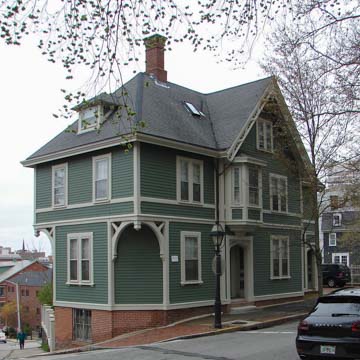Here are variant contemporaneous solutions in different styles by the same architect for nearly identical corner sites a block apart. Ambrose Burnside's eclectic brick mansard-roofed house in the Second Empire manner is the showier and more ambitious of the two architecturally and programmatically. Stone dared to locate the entrance of the house at its apex, in a curved bay, sweeping an entrance porch around it and out over the steeply sloping corner, while trailing the service wing down the hill along Planet Street. It was a conspicuous house for Rhode Island's contribution to the general staff of the Union Army, who continues to sit (in bronze, on his horse) in Kennedy Plaza. A rifle manufacturer, he returned to civilian life as an active politician, first as governor, then as United States senator.
The restrained Hall House would probably have been designated as Modern Gothic at the time. It was built for the widow of a beloved pastor of the Unitarian Church with funds contributed by grateful parishioners. Clipped on a diagonal at the corner of its ground story, the upper story extends on bracketing to a full right angle, while downhill the mass nicely adjusts to the street diagonal. The inset door with its second-story bay poking into a corner of the front gable is delightfully quirky.

